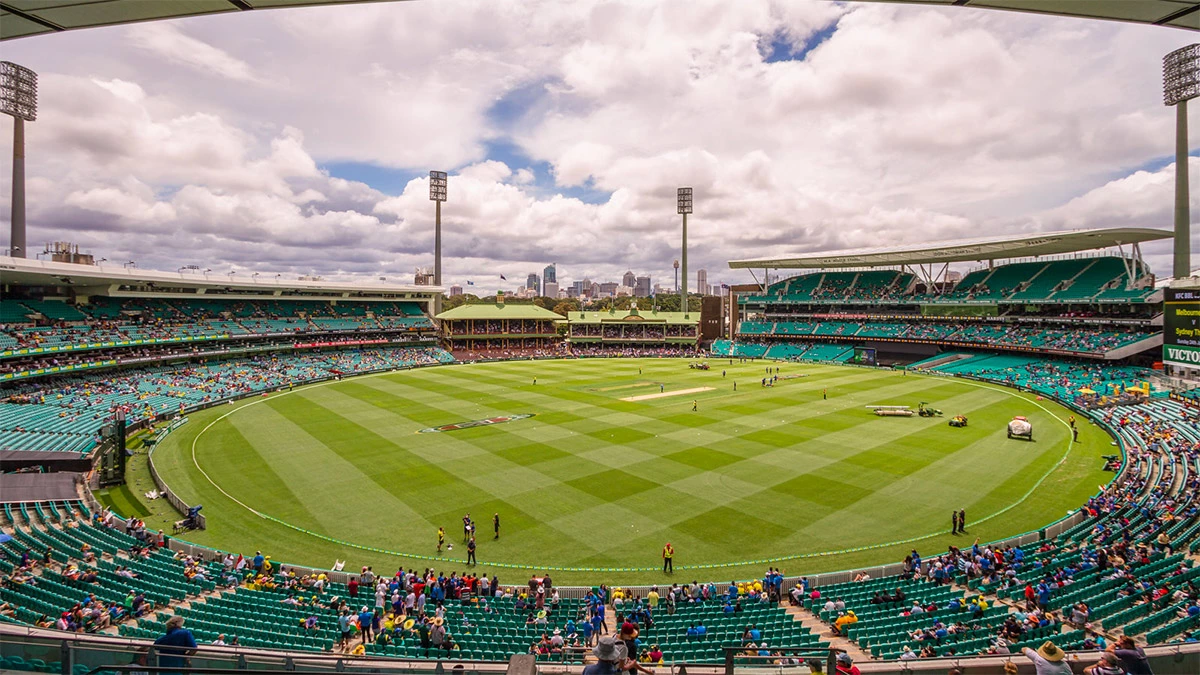
The Sydney Cricket Ground (SCG), steeped in a history dating back to 1811, stands as one of Australia’s oldest ground and most revered sports stadiums.
Originally known as the Garrison Ground, it underwent a transformation into a cricket venue in 1851.
The SCG officially opened its gates in February 1854, becoming a key sporting venue, especially after Hyde Park ceased hosting sports in 1856.
With a seating capacity of approximately 48,000, the SCG ranks among the largest cricket grounds globally.
Its unique atmosphere is shaped by a series of separate grandstands, each named after legendary players, adding historical reverence to the spectator experience.
As a home of New South Wales Cricket Team, and Sydney Sixers, the pitch is known for consistent bounce and speed, favoring both batsmen and bowlers.
Throughout its illustrious history, the SCG has witnessed iconic moments, including Don Bradman’s record-breaking innings and memorable events like the first night cricket.
Summary & Key Takeaways
ShowThe History of Sydney Cricket Ground
- Historical Development: Established in 1811, the SCG became a key sporting venue in 1854, gaining prominence in the 1870s.
- Early Developments: Initial constructions included grandstands and spectator mounds; formal dedication occurred in 1876.
- Infrastructure Upgrades: The Members' Pavilion (1886) and tram loop (1881) improved access; the Hill Stand was added in 1894.
- 20th Century Renovations: Don Bradman's era saw major renovations; World Series Cricket in 1978 introduced night cricket.
- Recent Redevelopments: The 21st century saw continued upgrades, raising the capacity to 48,000 by 2014.
Stadium Capacity
- Seating Capacity: Approximately 48,000, ranking among larger cricket grounds globally.
- Historical Seating: Evolved from separate grandstands to various modern stands.
- Fan Experience: Offers a diverse and engaging atmosphere with historical reverence.
Pitch and Conditions
- Pitch Characteristics: Known for fair competition; historically spin-friendly.
- Soil Composition: Primarily Bulli soil; traditional soil foundation maintained.
- Weather Impact: Rainfall influences pitch behavior, requiring player adaptability.
Memorable Matches and Moments
- Iconic Matches: Hosted the Tied Test (1960), 2003 Rugby World Cup semi-final, 2005-06 Ashes Test.
- Historical Significance: Venue for Australia's first Test victory over England (1882).
- Record Performances: Bradman's highest first-class score (1929); Yuvraj Singh's six sixes (2007).
Visitor Information Overview
- Location: In Moore Park, near Sydney's CBD.
- Accessibility: Best accessed via public transport; parking available in Centennial Park.
- Facilities: Offers diverse food options, engaging fan activities, and modern amenities.
Sydney Cricket Ground: Australia’s Oldest Ground that Still Stand

The Sydney Cricket Ground (SCG), steeped in history dating back to 1811, is one of Australia’s most cherished sports venues.
Its substantial seating capacity places it among the larger cricket grounds worldwide, offering a unique atmosphere characterized by separate grandstands named after cricket legends.
The pitch’s consistent bounce and speed make it favorable for both batsmen and bowlers. Over the years, the SCG has been witness to numerous iconic moments and has hosted significant cricket events. Here some key point to remember:
The History of Sydney Cricket Ground
The Sydney Cricket Ground (SCG), initially known as the Garrison Ground, unveils a rich tapestry of history dating back to 1811. Initially part of Sydney Common, the area was transformed into a cricket ground for soldiers in 1851.
The official opening in February 1854 marked its transition to a key sporting venue, especially after Hyde Park ceased hosting sports in 1856.
The SCG, initially unpopular due to its distance from the city, gained prominence in the 1870s with regular use by the New South Wales Cricket Association (NSWCA).
Notable developments in its early years include the construction of grandstands and the transformation into the Civil and Military Ground when aligned with the East Sydney Cricket Club.
Richard Driver, NSWCA president, played a pivotal role in its administration. The ground was formally dedicated in 1876 and hosted its first Sydney cricket test in 1882, boasting two grandstands and two spectator mounds, The Hill and Paddington Hill.
Subsequent decades saw the SCG evolve with multiple upgrades. The Members’ Pavilion, rebuilt in 1886, and a tram loop built in 1881, enhanced access.
By 1894, it adopted the name Sydney Cricket Ground and introduced the Hill Stand. Innovations like the first scoreboard in 1895-1896 and the opening of the Ladies’ Stand in 1896 marked significant milestones.
The 20th century heralded dramatic changes. Don Bradman’s era in the 1920s and 1930s saw major renovations, including the M.A. Noble Stand and later the Bradman Stand.
The advent of World Series Cricket in 1978 catalyzed further modernization, with the introduction of night cricket and the construction of six light towers.
Major stands like the Brewongle and Churchill stands were built in the 1980s, with ongoing upgrades to scoreboards and seating arrangements.
The 21st century continued this trend of redevelopment. The NSW Cricket Centre opened in 1997, and the Victor Trumper Stand in 2008 increased capacity to 46,000.
The most recent major redevelopment for the 2013-14 Ashes series raised capacity to 48,000 spectators.
Throughout its history, the SCG has hosted numerous iconic cricket moments. The first recorded match in 1854 saw the Garrison Club defeat the Royal Victoria Club.
Its first Test match in 1882 featured an Australia win over England. Don Bradman set a record in 1928-29 with a first-class innings of 452 runs.
This ground hosted witnessed many stars born, and stands as home grounds for New South Wales Cricket Team, and Sydney Sixers.
Memorable events include the first night cricket in 1978, Shane Warne’s first and final Tests, and Michael Clarke’s triple century in 2012.
The SCG also hosts the traditional New Year Tests and the Pink Test for breast cancer awareness. Tragically, in 2014, Phillip Hughes was fatally injured at the SCG, a somber reminder of the sport’s unpredictability.
Stadium Capacity
The Sydney Cricket Ground (SCG) stands as one of Australia’s oldest and most revered sports stadiums, offering a seating capacity of approximately 48,000.
This capacity places it among the larger cricket grounds worldwide, although it falls short of the colossal capacities of some global stadiums like the Narendra Modi Stadium in India, which can accommodate 132,000 spectators.
Over the years, the SCG’s seating capacity has evolved with its various redevelopment projects. Initially, the ground featured separate grandstands, a design that offered different viewing experiences depending on the seating location.
This aspect remains despite numerous renovations, including the addition of the Bill O’Reilly Stand, the Brewongle/Clive Churchill Stands in the 1980s, and the more recent Victor Trumper Stand, completed in 2008.
Comparatively, the SCG’s capacity ranks it alongside other major stadiums such as Docklands Stadium in Melbourne, which has a slightly higher capacity of 48,003, as per the list of cricket grounds by capacity.
The record for the highest attendance at the SCG was set on December 15, 1928, during a cricket match between Australia and England, drawing a crowd of 58,446.
In terms of fan experience, the SCG offers a diverse and engaging atmosphere. The stadium’s design, with its series of separate grandstands, provides varied viewing experiences.
Each stand, named after legendary players, adds a touch of historical reverence to the spectator’s experience.
The fan engagement extends outside the stadium as well, with various activities along Driver Ave on game days.
The Twenty20 cricket format, particularly popular at the SCG, is known for its fast-paced and entertaining nature, enhancing the fan experience.
Pitch and Conditions
The Sydney Cricket Ground (SCG) is known for a pitch that encourages fair competition between bat and ball, owing to its consistent bounce and speed.
The clay-based soil, primarily Bulli soil from New South Wales, contributes to these characteristics.
Notably, the SCG is one of the few major test venues in Australia that hasn’t switched to a drop-in pitch, maintaining its traditional soil foundation.
Historically, the SCG is regarded as one of Australia’s most spin-friendly international cricket grounds.
However, recent feedback from players like Australia’s Steve Smith and India’s Virat Kohli suggests that the pitch has shown less variable bounce and slower conditions than expected in some matches.
Weather also plays a significant role in the pitch’s behavior, with rainfall potentially leading to a damp surface, resulting in slower and lower bounce.
Those demands adaptability from players, requiring bowlers to adjust their techniques to exploit movement or spin, and batsmen to account for bounce and speed variations.
In terms of match statistics, the SCG has hosted 103 Test matches, with a predominant number of home wins (57) compared to away wins (28) and draws (18).
The last ten Tests have seen 8 home wins, suggesting a certain degree of advantage for the home side due to the pitch’s unique characteristics.
Memorable Matches and Moments
The Sydney Cricket Ground (SCG) has witnessed numerous iconic matches and moments that have left an indelible mark on the sport’s history. These range from groundbreaking performances to emotional farewells.
Iconic Matches
- The Tied Test between Australia and the West Indies in 1960, known as one of cricket’s greatest matches.
- The 2003 Rugby World Cup semi-final between Australia and New Zealand.
- The 2005-06 Ashes Test, where Shane Warne took his 700th test wicket.
Historical Significance
- In 1882, Australia’s first-ever victory over England in Test cricket occurred at the SCG.
- The 1971 Test against England marked the start of one-day international cricket.
Record-Breaking Performances
- Don Bradman scored his highest first-class score of 452 not out at the SCG in 1929.
- Yuvraj Singh’s six sixes in an over during the inaugural T20 World Cup in 2007.
- Ricky Ponting’s 257 against India in 2003, one of the highest individual scores at the ground.
Dramatic Finishes
- The 1982-83 Ashes Test, where England won by three runs.
- The 2007-08 India Test, where Michael Clarke took three wickets in the final over to secure an Australian win.
Emotional Farewells
- The 2007 Test against England was Shane Warne, Glenn McGrath, and Justin Langer’s final Test.
- In 2008, Steve Waugh played his final Test match against India.
- Sachin Tendulkar’s 100th international century was widely anticipated but ultimately not achieved at the SCG in 2012.
Facilities and Aminities
The Sydney Cricket Ground (SCG) is not just renowned for its rich cricket history but also for its modern facilities and features that enhance the spectator experience.
The SCG has a capacity of approximately 48,000, offering diverse viewing experiences due to its design of separate grandstands. Each stand, such as the Bill O’Reilly Stand and the Brewongle/Clive Churchill Stands, provides a unique view of the action.
The ground features historic stands like the Members Pavilion and Ladies Stand, which date back to 1886 and 1896, respectively. Here the key aspects:
- Modern Amenities: Recent renovations have brought state-of-the-art facilities to the SCG, including upgraded seating, improved concession areas, and enhanced accessibility for fans with disabilities.
- Digital Experience: The SCG boasts modern digital scoreboards and video screens, providing instant replays and player stats, enhancing the in-game experience for fans.
- Food and Beverage Options: There are numerous food and beverage outlets around the ground, offering a variety of options from traditional stadium fare to more gourmet choices.
- Fan Engagement: Outside the stadium, particularly on game days, there are various fan engagement activities along Driver Ave, adding to the match-day experience.
- Transport and Access: While access to the SCG can be challenging during large events due to traffic, there are parking options in the parklands opposite the ground. Public transport is often a recommended option for fans attending events.
- Security and Safety: Like many modern sports venues, the SCG has security checks at entry points to ensure the safety of all attendees.
- Multi-purpose Use: Apart from cricket, the SCG also hosts other sports like Australian Rules Football, Rugby League, and Rugby Union, making it a versatile venue.
- Training and Administrative Facilities: The NSW Cricket Centre at the SCG includes indoor training wickets and administrative offices, demonstrating its role as a hub for cricket in New South Wales.
Location and Accessibility
Sydney Cricket Ground (SCG) is situated in Moore Park, around 4km from Sydney’s central business district. The full address is Driver Ave, Moore Park, Sydney, New South Wales 2021, Australia.
This venue is near the vibrant Paddington neighborhood and close to the Entertainment Quarter’s bars, restaurants, cinemas, and shops.
Public transport, especially light rail services, offers convenient access to the SCG. The L2 Randwick Line’s light rail services from Central Railway Station (via Chalmers Street) stop at Moore Park, located on Anzac Parade just south of the SCG.
Taxi ranks are available in the Entertainment Quarter on Errol Flynn Boulevard. For parking, the MP1 Car Park caters to members (access via Driver Avenue), while event day parking is accessible at Centennial Park opposite the stadium.
The SCG has six entry gates: Gate A, Gate B, Gate C, Gate D, Gate E, and Gate F. Ticket holders can enter the ground through any of these gates. Tickets can be purchased online, over the phone, or at the stadium box office.
However, access to the SCG can be challenging, especially during large events, with traffic congestion and limited parking options.
Security checks are standard, and seating areas are typically restricted to specific sections, often with upper decks in grandstands closed for less-than-capacity crowds.
Architecture
The Sydney Cricket Ground (SCG) is an eclectic mix of architectural styles, reflecting its long and storied history.
The earliest parts of the ground, such as the Ladies’ Pavilion, are in a Moorish style, while more recent additions, such as the Brewongle Stand, are in a more modern style.
The SCG has been designed and built by a number of different architects and builders over the years.
Some of the most notable architects include John Kirkpatrick, who designed the Ladies’ Pavilion, and Cox Architecture, who designed the M.A. Noble Stand.
The SCG has a traditional oval-shaped layout, with the pitch at the center of the ground.
The stands are arranged around the perimeter of the ground, with the largest stands located at the northern end.
Meanwhile, the SCG has a partially covered roof, which provides shade for spectators in the northern stands.
Final Words about Sydney Cricket Ground
The Sydney Cricket Ground, steeped in history since 1811, stands as a prominent 48,000-capacity cricket venue. It’s celebrated for hosting historic cricket moments, including iconic Test matches and emotional farewells.
Its unique design, a blend of Moorish and modern architectural styles, alongside facilities like modern scoreboards and diverse seating, enriches the spectator experience.
However, the pitch, favoring spin yet presenting changing conditions, poses a challenge: How would your favorite team adapt to the Sydney Cricket Ground’s dynamic environment?
Anything You Need to Know about Sydney Cricket Ground
Is Sydney Cricket Ground a batting pitch?
The Sydney Cricket Ground (SCG) is generally considered to be a balanced pitch that offers a fair contest between bat and ball. However, the conditions can vary depending on the time of year and the weather. In general, the pitch is more conducive to batting early in the season, when the wickets are drier and harder. Later in the season, as the wickets become more worn and uneven, the pitch can become more difficult to bat on.
Is the Sydney Ground big or small?
The Sydney Cricket Ground (SCG) has a capacity of approximately 48,000 spectators, making it one of the largest sporting venues in Australia. It is not as large as the Melbourne Cricket Ground (MCG), which has a capacity of 100,024 spectators, but it is still a very large and impressive stadium.
Is SCG spin-friendly?
The Sydney Cricket Ground (SCG) is known for being a relatively spin-friendly pitch, particularly later in the season when the wickets are more worn and uneven. This is because the soil and foundation of the pitch and playing surface is primarily ‘Bulli soil’ from Bulli, New South Wales. Bulli soil is a clay-based soil that tends to hold moisture well, which can make it difficult for batsmen to play spin bowling.










